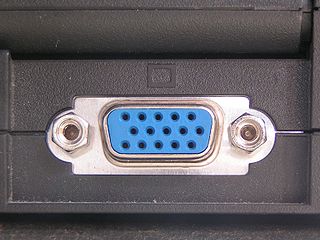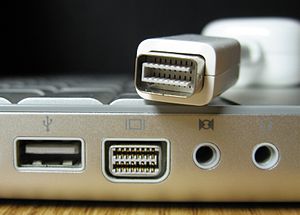
Digital Visual Interface (DVI) is a video display interface developed by the Digital Display Working Group (DDWG). The digital interface is used to connect a video source, such as a video display controller, to a display device, such as a computer monitor. It was developed with the intention of creating an industry standard for the transfer of uncompressed digital video content.

The D-subminiature or D-sub is a common type of electrical connector. They are named for their characteristic D-shaped metal shield. When they were introduced, D-subs were among the smallest connectors used on computer systems.
Apple Inc. has sold a variety of LCD and CRT computer displays since introducing their first display in 1980. Apple paused production of their own standalone displays in 2016 and partnered with LG to design displays for Macs. In June 2019, the Pro Display XDR was introduced, however it was expensive and targeted for professionals. In March 2022, the Studio Display was launched as a consumer-targeted counterpart. These are currently the only Apple-branded displays available.

The Apple Display Connector (ADC) is a display and data connector developed by Apple, Inc. as a proprietary modification of the DVI connector. ADC combines analog and digital video signals, USB, and power all in one cable. It was used in later versions of the Apple Studio Display, including the final 17" CRT model, and most versions of the widescreen Apple Cinema Display, after which Apple adopted standard DVI connectors on later models.

High-Definition Multimedia Interface (HDMI) is a proprietary audio/video interface for transmitting uncompressed video data and compressed or uncompressed digital audio data from an HDMI-compliant source device, such as a display controller, to a compatible computer monitor, video projector, digital television, or digital audio device. HDMI is a digital replacement for analog video standards.

The Video Graphics Array (VGA) connector is a standard connector used for computer video output. Originating with the 1987 IBM PS/2 and its VGA graphics system, the 15-pin connector went on to become ubiquitous on PCs, as well as many monitors, projectors and HD television sets.

Mini-VGA connectors are proprietary and non-standard alternative video connectors that were used on some laptops and other computer systems in place of a standard VGA connector. Apple, HP, and Asus each introduced separate connectors using the same moniker of "mini-VGA", but which are otherwise physically incompatible with each other.

The Apple Cinema Display is a line of flat-panel computer monitors developed and sold by Apple Inc. between 1999 and 2011. It was initially sold alongside the older line of Studio Displays, but eventually replaced them. Apple offered 20, 22, 23, 24, 27, and 30-inch sizes, with the last model being a 27-inch size with LED backlighting.

DB13W3 (13W3) is a style of D-subminiature connector used for analog video interfaces. The 13 refers to the total number of pins, the W refers to workstation and the 3 refers to the number of high-frequency pins. The connector was something of a pseudo-standard for high-end graphical workstations from the early 1990s to the early 2000s.

DisplayPort (DP) is a proprietary digital display interface developed by a consortium of PC and chip manufacturers and standardized by the Video Electronics Standards Association (VESA). It is primarily used to connect a video source to a display device such as a computer monitor. It can also carry audio, USB, and other forms of data.

The MacBook is a line of Mac laptops sold by Apple Inc. between May 2006 and February 2012. It replaced the iBook series of notebooks as a part of Apple's transition from PowerPC to Intel processors. Positioned as the low end of the MacBook family, below the premium ultra-portable MacBook Air and the performance-oriented MacBook Pro, the MacBook was aimed at the consumer and education markets. It became the best-selling Mac in Apple's history. For five months in 2008, it was the best-selling laptop of any brand in US retail stores.

DMS-59 was generally used for computer video cards. It provides two Digital Visual Interface (DVI) or Video Graphics Array (VGA) outputs in a single connector. A Y-style breakout cable is needed for the transition from the DMS-59 output to DVI (digital) or VGA (analogue), and different types of adapter cables exist. The connector is four pins high and 15 pins wide, with a single pin missing from the bottom row, in a D-shaped shell, with thumbscrews. As of December 2020, this adapter cable was listed as obsolete by its primary vendor Molex.

The Micro-DVI port is a proprietary video output port introduced on the original MacBook Air in 2008. It is smaller than the Mini-DVI port used by its MacBook models.

Mac Mini is a small form factor desktop computer developed and marketed by Apple Inc. As of 2022, it is positioned between the consumer all-in-one iMac and the professional Mac Studio and Mac Pro as one of four current Mac desktop computers. Since launch, it has shipped without a display, keyboard, and mouse. The machine was initially branded as "BYODKM" as a strategic pitch to encourage users to switch from Windows and Linux computers.

The Mini DisplayPort is a miniaturized version of the DisplayPort audio-visual digital interface.

A dock connector is an electrical connector used to attach a mobile device simultaneously to multiple external resources. Dock connectors typically carry a variety of signals and power, through a single connector, to simplify the process of docking the device. A dock connector may be embedded in a mechanical fixture used to support or align the mobile device or may be at the end of a cable.
Audio connectors and video connectors are electrical or optical connectors for carrying audio or video signals. Audio interfaces or video interfaces define physical parameters and interpretation of signals. For digital audio and digital video, this can be thought of as defining the physical layer, data link layer, and most or all of the application layer. For analog audio and analog video these functions are all represented in a single signal specification like NTSC or the direct speaker-driving signal of analog audio.
Thunderbolt is the brand name of a hardware interface for the connection of external peripherals to a computer. It was developed by Intel in collaboration with Apple. It was initially marketed under the name Light Peak, and first sold as part of an end-user product on 24 February 2011.

The Apple Studio Display is a series of non-widescreen LCD and CRT displays manufactured and sold by Apple Computer, Inc. and introduced in 1998. After the 1999 introduction of the widescreen Apple Cinema Display, the Apple Studio Display line ran concurrently until it was discontinued in 2004. With the exception of the last model, the 5:4 17" Apple Studio Display, all Apple Studio Displays had an aspect ratio of 4:3.

The Apple Thunderbolt Display is a 27-inch flat panel computer monitor developed by Apple Inc. and sold from July 2011 to June 2016. Originally priced at $999, it replaced Apple’s 27-inch Cinema Display. For displays it can only connect with computers with a Thunderbolt port. It is incompatible with most non-Apple computers, along with Macs released before 2011 and the 2012 Mac Pro or the single USB-C Retina MacBook. For Devices with Thunderbolt 3 using a dongle will work with the Apple Display.


















